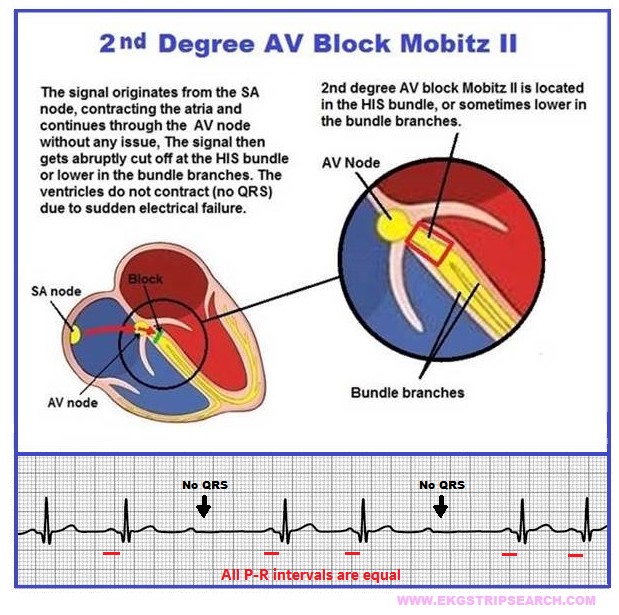Mobitz 2

|
2nd degree Mobitz 2 heart block is a defect or disease of the HIS bundle (His-Purkinje system) located below the AV node. The electrical signal from the SA node contracts the atria as usual (a P-wave on the ekg strip). However, after the AV node sends the signal down to contract the ventricles, it suddenly gets cut off (blocked) at the HIS bundle/bundle branches and the ventricles do not contract. Looking on an ekg strip (see illustration above), it shows no QRS following the P-wave, AKA "dropped beat". Mobitz 2 heart block has no P-R widening, all P-R intervals are the same. Mobitz 2 is more like an electrical shortage. Unlike Mobitz 1 (wenckebach), whereas the signal is delayed by a repolarizing exhaustion of the AV node which builds with consecutive beats. Mobitz 2 causes a sudden electrical failure and is more dangerous/threatening due to its location and instability. Mobitz 2 carries an elevated risk of having no escape rhythm emerging in the event of going into complete blockage/failure.  When there are multiple dropped beats between each QRS (see above), it is a higher risk. If there are three or more dropped beats between QRS's, it is considered a "high grade" block Both 2nd degree blocks; Mobitz 1 and Mobitz 2, prevent the ventricles from contracting. However, the mechanism in which they work are quite different from each other due to their location. Mobitz 1 (wencke): is located at the AV node and is often called, "AV nodal block". Mobitz 2: resides in the HIS bundle or lower in the bundle branches. It is referred to as "infranodal block" (below the AV node), or a "HISIAN Block" (HIS bundle). Causes:
Symtoms:
Treatment:
|
